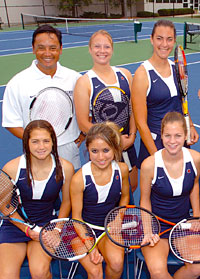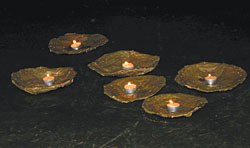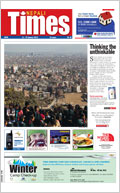 "Son, I want you to be a doctor or an engineer, or a pilot." Sound familiar? Did you feel the pressure to study science and math while growing up in Nepal? Was there really a choice? Although I experienced some of it, I am thankful my parents allowed me to explore other interests and let me choose my own path. My search eventually took me to a profession called coaching.
"Son, I want you to be a doctor or an engineer, or a pilot." Sound familiar? Did you feel the pressure to study science and math while growing up in Nepal? Was there really a choice? Although I experienced some of it, I am thankful my parents allowed me to explore other interests and let me choose my own path. My search eventually took me to a profession called coaching. In 1988, I came to Luther College in the United States to pursue a double degree in international relations and public communication. When I graduated in 1992, I wanted to work for the United Nations. I took a year off to work as a tennis coach in South Carolina with the famous tennis teacher Dennis Van Der Meer. Soon, I had fallen head over heels in love with tennis and made coaching my career.
Very early on, I realised I had a knack for motivating and inspiring students. What I lacked in knowledge of the finer points of tennis, I made up for with positive energy, enthusiasm and passion. To hone my technical and tactical skills, I obtained professional certification from the two largest tennis teaching organisations (PTR and USPTA). And for the last 13 years I have worked very hard to improve as a coach. I learn something new every day and that is exciting.
Success with the junior players gave me the opportunity to work with professional players. My time on the WTA tour with professional athletes such as Amanda Coetzer (South Africa) and Naoko Sawamatsu (Japan) was great for my growth as a coach. Working with players from all over the world gave me a sense that my college degree after all did not go to waste. I discovered being a coach at the collegiate level was my true passion.
A coach is essentially a teacher and the best teacher is one who knows his subject, is passionate about it, is well prepared and makes learning fun for students. They are also role models and have a tremendous impact on students. Coaches are most effective when they lead by example. To teach discipline, I must be disciplined. To teach loyalty, I must be loyal. To teach ethics, I must be ethical. As a coach, you play many roles. Sometimes you have to be tough and demanding and other times you are there to give a hug or just listen.
One of the best parts of my job is the opportunity to work with players over a period of four years. I can help them in all phases of their game and track their progress. Having developmental plans for each of my students and setting short and long term goals is very important.
My students not only need to know their destination but understand that the emphasis must be on the process itself. Positive feedback and the belief you have in them through the good and bad times is vital for your students' development. Effective coaching means holding your students accountable for their actions and being consistent in your dealings with them. The greatest thing about coaching is seeing your students succeed on and off the court.
"Son, I want you to be a doctor, or engineer, or a coach."
Sujay Lama will be conducting a tennis clinic for Nepali children in Kathmandu in December. [email protected]
 Throughout this dark decade of conflict, one thing that has never ceased to astonish us is the capacity of Nepalis to bear hardship, to adapt and survive. Even when shocking events overtook us, when the future looked hopeless, when the bloodletting got too much to bear, most Nepalis came through with their dignity and hope intact. It shows an innate resilience in the Nepali psyche.
Throughout this dark decade of conflict, one thing that has never ceased to astonish us is the capacity of Nepalis to bear hardship, to adapt and survive. Even when shocking events overtook us, when the future looked hopeless, when the bloodletting got too much to bear, most Nepalis came through with their dignity and hope intact. It shows an innate resilience in the Nepali psyche.
Over the years in these pages we have brought the voices of ordinary Nepalis brutalised by conflict. Despite their desperation and despair we hear them speak with inner strength about their faith in the future. What a contrast it is to hear the cynicism and negativity of the power brokers in Kathmandu. In fact it is the privileged among us, those who have the least reason to be cynical, who are the most pessimistic and disparaging.
In the past two months we have seen how little it takes for this country to bounce back. A unilateral ceasefire was all that was needed to make trekkers return and bring jobs and cash back to the trails, for the internally displaced to rush home for Dasain, for smiles to return to the faces of farmers. Villagers in Kailali who used to lock themselves up in their homes by seven every evening are partying in harvest festivals late into the night. And everywhere the people have the same advice to the warring sides: the Maoists should extend the ceasefire, and the army should reciprocate. The people know by now this war is a power struggle between the feudal right and fossilised left. And they have made it clear they want to have nothing to do with it.
By February it will be ten years since the Maoists started their "people's" war, so named, it seems, because nearly 14,000 people have died in it. Before September, an average of four Nepalis were being killed every day in the conflict. In the past two months, it has gone down to one a day. In the three weeks before Dasain, a total of 21 people were killed: 19 by the security forces and two by the Maoists. On the banks of Pokhara's Phewa Lake on Tuesday night peace activists floated candles in memory of the departed souls (pictured).
If the death toll fell to one-fourth with a unilateral ceasefire imagine if it was bilateral. An extended ceasefire would provide the atmosphere to sort out the mess February First got us into, and for the political parties to come up with something more than a kneejerk boycott of polls. That is our Tihar wish.


